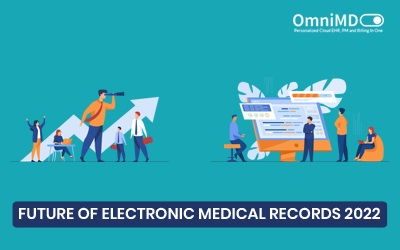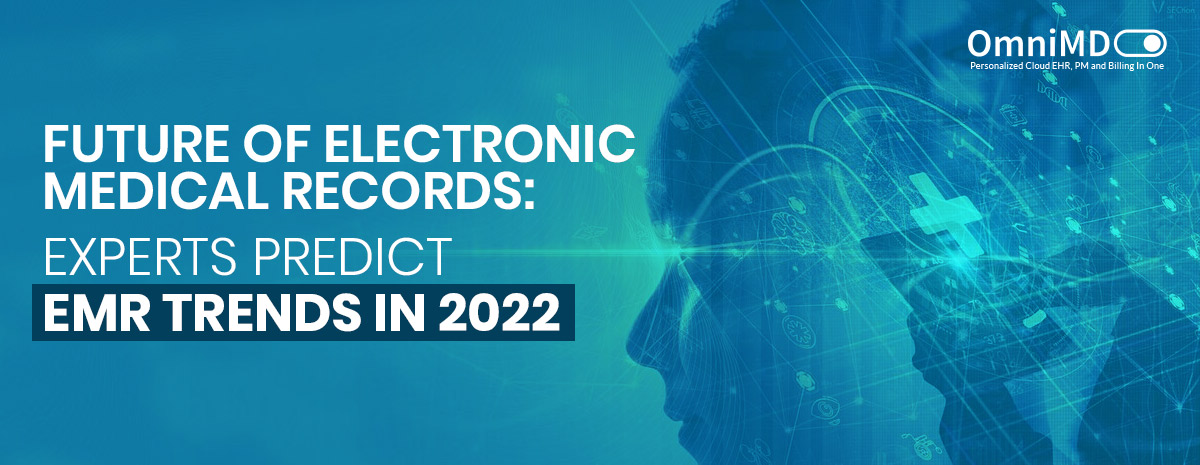Future of Electronic Medical Records: Experts Predict EMR Trends in 2022
With the advent of 2020, the world has seen some surprises. The COVID-19 arrival has shown how vital and valuable digital solutions are in solving the healthcare IT challenges. EHR and Electronic Medical Records Software have revolutionized the healthcare IT system with their process and techniques. But after 2020, automation has changed the picture.
The Electronic Medical Record (EMR) software is the tool for a completely paperless process concerning the patients, which is stored in an electronic form. The EMR are more efficient than hard-copy patient charts as they eliminate human efforts with automated data capture techniques for improved workflow. The EMR market can stimulate growth to be worth $60.70 billion by the year 2026, indicating the growing requirement for improved patient care and technological advancements.
Before delving into the upcoming trends to paint the future of EHR Software, have a glance at the interesting facts:
- 66% of software users search for medical concern information on the web.
- 88% of physician appointments are scheduled via phone calls.
With pandemic hitting now and then worldwide, the gradual switch to virtual health has become a boon. This has enabled the Electronic Health Record and Electronic Medical Records software to advance in leaps and bounds. Soon the EMR Companies will focus on creating software that is a value-based model along with a volume-based model as well. Let us look at the EMR Software trends to keep an eye out for in the future.
Accessibility
There would be a continued trend towards accessibility in EMR, both accessible for mobile and software. The main thing that holds back EMR is accessibility. The EMRs are very expensive, almost six or even seven figures for the total software price. This price can be cut down in the case of large hospitals and multi-facility networking hospitals with the help of government incentives, but that is not the case with the smaller practices.
Integration and Interoperability
Another issue with the Medical EHR software and EMR Software is their lack of capability with system integration. During any patient visit, the hospital needs to fetch the records from the outpatient practices, and other hospitals also need to get the full health records. This is why EMR accessibility would remain the top priority for every EMR company. This would reduce the manual work for the physicians and hospital staff to enter patient data, upload reports and scans or figure out crucial patient data.
Ease of Use
It is not easy for an individual EMR to fetch the data from the other EMRs. This is why there is a gap between fetching the data and the non-capability to do so. This is why there is a need for more easiness while navigating the data from one system to another. Despite having so many technological advancements, the EMR vendors face a tough time fetching the data.
Need A System for Accurate Data Capture
Every EMR and EHR need the protocol to capture data accurately and precisely. This would not only help generate better results but also eliminate human errors that might happen otherwise. Since these EMRs cover the entire patient’s historical data, capturing and saving the relevant and recently updated information is vital in the minimum possible time. This has enhanced the healthcare service digitization and will improve data integration with various techniques from multiple sources. These sources might include the mentioned but are not limited to point-of-care devices, wearable devices, and the cloud.
An Increasing Demand for Robotic Process Automation
As the EMR market is experiencing a gradual switch to automation, the EMR Vendors need to gain momentum with the trend. And with Robotic Process Automation (RPA), this would be further developed while maintaining the required accuracy by reducing the manual needs.
Standardization
The best way to legitimize the use of the EMR software is standardization. In this case, the EMR companies must provide some extra features and functionalities while maintaining the standards and regulations. And this standardization is not only required for data and functionalities but also E/M Codes, charge captures and more. Standardization will require inclusivity of changing dynamics as well. This will undoubtedly influence the EHR Vendors to develop their products and maintain their accessibility and strength.
Patient-Centric Engagement
To grow your EHR and EMR products, patient engagement is an essential part of the process wherein patient outreach and content creation is the positive add-on. Patient data and engagement is critical in data storage and analysis. This data can be collected from wearable intelligent devices or mobile devices.
However, wearable intelligent gadgets have become the talk of the town as this would provide excellent insight into the patients’ health. Patient engagement enhancement can also be done by sending appointment alerts and subsequent appointment reminders, and updating patient data from varied sources will reduce time and human efforts while improving patient engagement.
AI & Voice Recognition
In the healthcare market, IoT has seen a massive surge in usage. Several practices are looking to integrate IoT with AI features, which will help the provider diagnose the issue accurately and identify the patient health trends. Many EHR vendors are looking to implement and execute this feature in their EHR software. Along with this, Natural Language Processing (NLP) integration will improve provider/physician efficiency. This will also remove the language barrier as the AI and IoT systems will use natural spoken language in their designs.
The IoT-enabled healthcare market is expected to surge from the 2020s $50 billion to nearly $135 billion by 2025.
Concluding the Article
In the coming years, the industry will spectate the EMR and EHR products and services change for good. This change must continue putting pressure on the industry while changing and adapting for its sound. In the coming half the decade, the healthcare IT industry will see unprecedented transformations along with the required digitization changes.
—————–—————–—————–—————–—————–—————–—————–—————-
Looking for an in-depth idea of the EMR Trends and their adaptation? Connect with the experts here!


